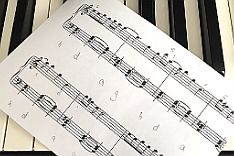Content
Extended choice of trade mark types – attractive variants for a modern brand appearance

Amended requirements support new types of trade marks
Whereas in the past, register marks had to be capable of being represented graphically, since January 2019, the only requirement has been that they can be identified with sufficient clarity and precision. Thus, for example, noise-like sound marks, multimedia marks, holograms and other types of marks in appropriate electronic formats can now also be registered as trade marks, provided that no grounds for refusal exist. The purpose of this increased variety of labelling methods is to accommodate the needs of the market for modern types of trade marks.
Of course, all classic types of trade marks (especially word and figurative marks) can still be applied for and be filed using graphic representation. Particularly in the case that an applicant might also be interested in an international registration of his mark, he even has to restrict himself to this conventional method of representation, because the World Intellectual Property Organization (WIPO) still requires a representation of the trade mark in the form of a two-dimensional graphic representation.
The exact requirements for the representation of the individual types of trade marks can be found in
- sections 8 (1), 32 (2) no. 3 of the Trade Mark Act, sections 6a, 7 et seq. of the Trade Mark Ordinance
- the Announcement of the readable types of data carriers at the DPMA and the formats for the representation of trade marks (section 6a of the Trade Mark Ordinance) of 10 January 2020 and
- in the Common Communication on the representation of new types of trade marks of the European IP offices with definitions and means of representation with file formats.
- den §
 section 8 (1)of the Trade Mark Act,
section 8 (1)of the Trade Mark Act,  setion 32 (2) no. 3 of the Trade Mark Act,
setion 32 (2) no. 3 of the Trade Mark Act,  sections 6a, 7 et seq. of the Trade Mark Ordinance (only in German)
sections 6a, 7 et seq. of the Trade Mark Ordinance (only in German) - der Announcement of the readable types of data carriers at the DPMA and the formats for the representation of trade marks (section 6a of the Trade Mark Ordinance) of 10 January 2020 und
- in der
 Common Communication on the representation of new types of trade marks of the European IP offices mit Definitionen und Darstellungsmitteln mit Dateiformaten.
Common Communication on the representation of new types of trade marks of the European IP offices mit Definitionen und Darstellungsmitteln mit Dateiformaten.
| Type of trade mark | Representation |
|---|---|
| Three-dimensional mark | OBJ, STL, X3D or grahic on paper/JPEG |
| Sound mark | MP3 or graphic in musical notation on paper/JPEG |
| Pattern mark | graphic representation on paper/JPEG |
| Motion mark | MP4 oder graphic on paper/JPEG |
| Hologram mark | MP4 or graphic on paper/JPEG |
If several means of representation are acceptable

If several means of representation are acceptable for one type of trade mark, you, as the applicant, can decide which means you want to choose. Please note that this choice may affect the subject matter of protection and the later scope of protection:
For example, a melodious sound mark interpreted by piano and represented by means of an MP3 file will protect exactly this piano interpretation of the melody. On the other hand, the representation by means of the pure musical notation will protect the melody – abstractly – as such, leaving it open how the melody is played.
If the indicated type of trade mark and the chosen representation actually contradict each other, the DPMA will clarify the subject matter of protection to be clearly defined. If, for example, you file an MP3 with a sung word and choose the trade mark type ''word mark'', the trade mark section would inquire whether you wish to apply for a sound mark (in MP3 representation) or a word mark (represented by means of a sequence of letters forming the word).
Other trade marks as catch-all
Through other trade marks under section 12a of the Trade Mark Ordinance, the DPMA offers the option of applying for types of trade marks which are not expressly mentioned by the Trade Mark Act. These must be represented in the most appropriate format (usually JPEG, MP3, MP4) or in an exceptional case – if no other representation is possible – by text only. However, the option of representing another type of trade mark by text is currently only available in Germany. Therefore, please note that you will probably not be able to claim priority in a later international trade mark application for such other type of trade mark which is represented by text alone.
The appropriate means of representation of other types of trade marks depends very much on their respective nature – at any rate, it must clearly define the subject matter of protection of the trade mark.
| Kind of the other type of trade mark | Representation |
|---|---|
| Combination of different types of trade marks, such as colour/position marks, hologram/pattern marks, light/sound marks | MP4, possibly with description |
| Other types of trade marks not expressly mentioned in the Trade Mark Act, e.g. light mark | MP 4 with description |
| Trade mark directed at senses other than sight or hearing, for example a tactile mark (for objectively standardised materials) | Representation by text |
| Conceptual type of trade mark, e.g. adjusting the temperature of a swimwear shop to 5 degrees | Representation by text |
Eligibility for protection – according to known principles
The examination as to whether a trade mark applied for is capable of being protected is carried out on the basis of the well-known principles that apply to all other types of trade marks: Therefore, also with regard to the new types of trade marks, all usual product-, technology- and value-related characteristics cannot be protected (section 3 (2) of the Trade Mark Act). However, any element capable of being protected is generally sufficient (section 8 (2) of the Trade Mark Act).
In particular, however, trade marks which cannot be represented graphically must also be distinctive, i.e. capable of distinguishing the goods and services of one undertaking from those of another undertaking. The question of what effect a trade mark has on a participant in the specific trade sector is crucial for the assessment of that distinctiveness – in this area corresponding principles will only evolve with an increasing number of such new trade marks.
To assess whether modern types of trade marks are capable of being protected, it may be worthwhile to check DPMAregister for new types of trade marks as from 14 January 2019 and thus find out which trade marks have been registered and which have not.
Further developments
The limited number of applications for new types of trade marks at the DPMA has already given rise to some questions. Among many other fundamental issues, we have introduced these questions into the currently ongoing European convergence project ![]() Consultation on CP11: "New Types of Trade Marks" with the subprojects "Work-stream 1: Examination of formal requirements and absolute grounds for refusal and invalidity" and "Work-stream 2: Examination of relative grounds for refusal and invalidity". As soon as the results of this project are available, you will find detailed and helpful information here.
Consultation on CP11: "New Types of Trade Marks" with the subprojects "Work-stream 1: Examination of formal requirements and absolute grounds for refusal and invalidity" and "Work-stream 2: Examination of relative grounds for refusal and invalidity". As soon as the results of this project are available, you will find detailed and helpful information here.
New types of trade marks – tips
- Before filing an application, carefully consider which type of trade mark you want to choose and the effects this will have.
- Please note the acceptable file formats.
Get ready to tread new paths!
Picture 1: istock.com/Design Cells, Picture 2: DPMA
Last updated: 22 November 2024

Not only protecting innovations
Social Media